Friday, 24 May 2013: Vaison la Romaine
Written Monday, 10 June 2013
Friday, our last full day in Avignon, we set off at 11 a.m. for Vaison la Romaine. We'd driven by it earlier—it was the most distant point on the loop we drove on the day we visited Châteauneuf du Pape—but we hadn't stopped in to visit its amazing Roman ruins. By lying to the GPS about where we were going, then reprogramming en route, we forced it to direct us by a different route this time, throught a few more little wine towns that David wanted to take a look at

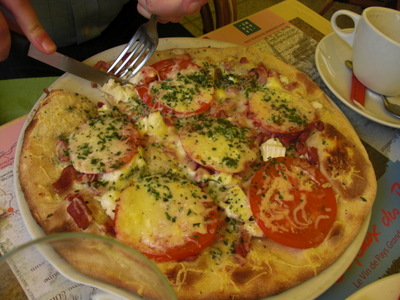 Vaison is also set up to handle large numbers of tourists, though on the cool and rainy day we were there, it wasn't at all crowded, and we parked easily. We found lunch at a café on the main square. We ate on the terrace, but the restaurants had set up large tents with clear plastic sides over the tables to ward off the wind and rain.
Vaison is also set up to handle large numbers of tourists, though on the cool and rainy day we were there, it wasn't at all crowded, and we parked easily. We found lunch at a café on the main square. We ate on the terrace, but the restaurants had set up large tents with clear plastic sides over the tables to ward off the wind and rain.
CJ and Jeff both ordered pizzas. CJ's is on the left, covered with tomato sauce, cheese, and olives. Jeff's had fresh tomatoes, ham, and three cheeses, including brie.
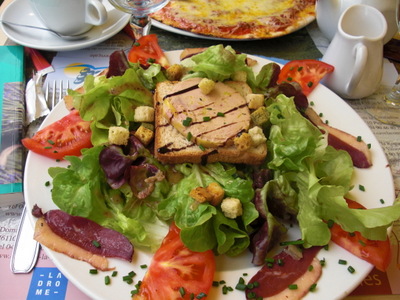
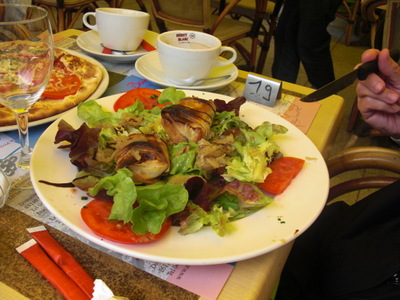 I had another salad of foie gras, magret de canard, and toast. Once again, sigh, the toast was, well, not quite Wonderbread, but, say, Pepperidge Farm.
I had another salad of foie gras, magret de canard, and toast. Once again, sigh, the toast was, well, not quite Wonderbread, but, say, Pepperidge Farm.
David's goat-cheese salad was more interesting. The cheese was wrapped in feuilles de brik and baked until the pastry was crispy. The greens themselves, in both salads, were excellent, but all in all, I think the pizzas looked better. Pizzas in France are always single-serve size, but these struck me as particularly large.
Vaison was larger as a Roman city than it is today, so several large areas of the town are free of modern buildings and have been excavated to reveal the Roman ruins beneath. Most of them take the form of foundations, floors, and knee- to waist-high remains of walls. Individual houses are named form something found during their excavation, like the House of the Laureate Apollo (for a statue), the Barrel House, and the Peacock villa.

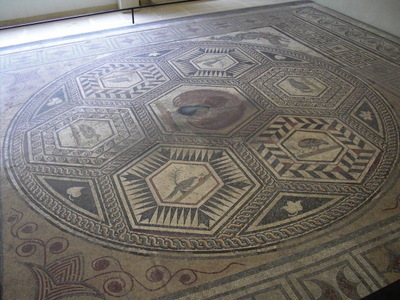 Because it was so cool and the rain was threatening, we started with the museum, where we would be indoors. On one wall, I found this great map of the Narbonne, the Roman province in which Provence was located. It stretches from what is now Nice at the right to beyond Toulouse at the left and from Marseille at the mouth of the Rhône (which is shown as a heavy blue line on the map) to Vienne (on the river just below the northern edge of the map) and Geneva at the top right.
Because it was so cool and the rain was threatening, we started with the museum, where we would be indoors. On one wall, I found this great map of the Narbonne, the Roman province in which Provence was located. It stretches from what is now Nice at the right to beyond Toulouse at the left and from Marseille at the mouth of the Rhône (which is shown as a heavy blue line on the map) to Vienne (on the river just below the northern edge of the map) and Geneva at the top right.
This magnificent mosaic floor came from the ruins of one of the houses (presumably the Peacock Villa).
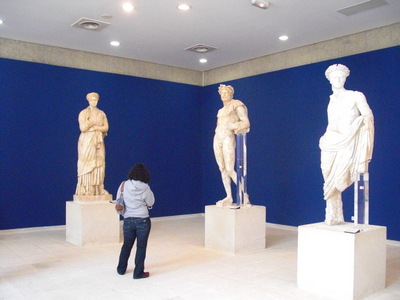
 Here CJ strolls among some of the denizens of the ruined houses and public buildings. She's small, but not that small—the statues are larger than life size. The one in the middle is the emperor Hadrian, and the room also included emperors Domitian and Claude. Several of the others were also of identified real people.
Here CJ strolls among some of the denizens of the ruined houses and public buildings. She's small, but not that small—the statues are larger than life size. The one in the middle is the emperor Hadrian, and the room also included emperors Domitian and Claude. Several of the others were also of identified real people.
On the right is a model of Vaison's Roman theater—its scene wall has not survived, but the foundations of it are visible. Along the back rim, above the seats, are some of the columns that held the cables supporting the retractable canvas sunshade.
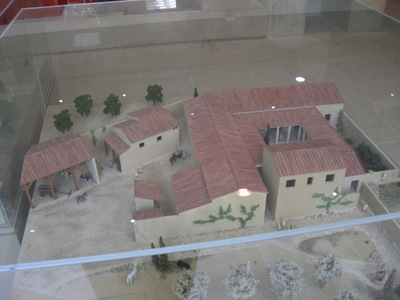
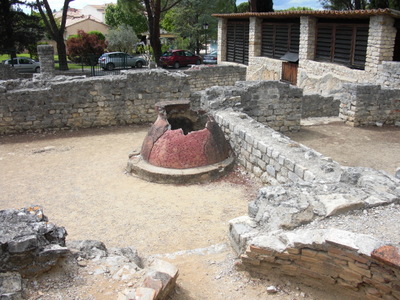 The model on the left here is of one of the houses that has been excavated. Only the foundations remain, revealing the layout, and the rest was reconstructed from what was already known about Roman architecture of the time.
The model on the left here is of one of the houses that has been excavated. Only the foundations remain, revealing the layout, and the rest was reconstructed from what was already known about Roman architecture of the time.
On the right is what remains of the kitchen of one of the excavated houses (perhaps the one in the model; I'm not sure). Note the single large dolia set in the floor, which would have been used to store grain, or maybe oil. The kitchen also included several hearths for cooking fires. We walked through several such houses within the enclosure that included the museum and theater. Several other such enclosures are scattered around the town, but we didn't have time to visit the others.

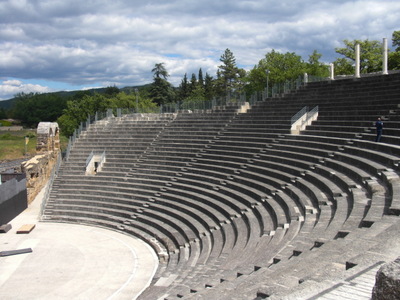 The Roman theater is set into a hillside, but on the other side of the hill from the museum enclosure, facing away from the town. To get there the Romans (and, today, visitors) would have to walk up and over the top of the hill, but being the Romans, they couldn't be bothered to do that. Instead, partway up the hill, they drilled this pedestrian tunnel through the (mostly solid rock) hilltop. It comes out just a little above the side entrance to the theater, from which I took the photo on the right.
The Roman theater is set into a hillside, but on the other side of the hill from the museum enclosure, facing away from the town. To get there the Romans (and, today, visitors) would have to walk up and over the top of the hill, but being the Romans, they couldn't be bothered to do that. Instead, partway up the hill, they drilled this pedestrian tunnel through the (mostly solid rock) hilltop. It comes out just a little above the side entrance to the theater, from which I took the photo on the right.
Like the others we toured on this trip, this theater is still in use today; workmen were setting up a modern state for an upcoming show. The structures in Vaison are not necessarily the best preserved, but for sheer extent of excavated area and information revealed about everyday life (as opposed to imposing public monuments), Vaison beats every place we've been except Vienne, just south of Lyon (see my 2011 diary).
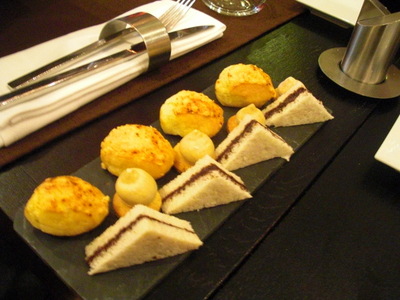
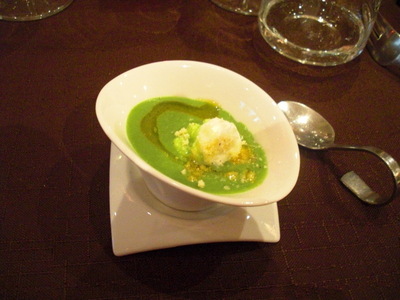 Back in Avignon, we strolled up to Les 5 Sens for dinner. We had the "Menu Gourmande," but it offered so many choices that we wound up eating many different things.
Back in Avignon, we strolled up to Les 5 Sens for dinner. We had the "Menu Gourmande," but it offered so many choices that we wound up eating many different things.
The first amuse-bouche was this tray (well, slat slab) of munchies: tapenade finger sandwiches, little "onion domes" of foie gras on savory shortbread cookies, and puffy warm gougères (unfilled savory cream puffs with cheese in the batter).
The second was yet another delicious green pea soup with herb-infused oil and a little scoop of brandade de morue sprinkled with crispy crumbs.

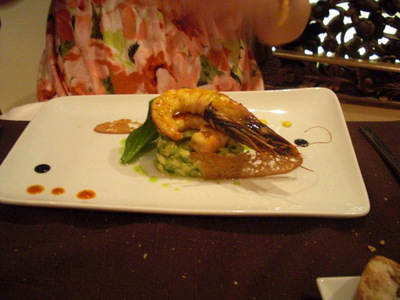 First course, me: Foie gras two ways—a slice from a cold terrine and a tiny "slider" of saut&*eacute;ed foie gras in a miniature bun. On the side, round toasts, a quenelle of "vieux garçon" preserves, and a glass of sweet wine from Rasteau (one of the villages we had just driven through on the way to Vaison). To make vieux garçon ("bachelor") preserves, you put sugar and white fruit brandy in a large jar, then all season long, as fruit comes into season, you chop it up and stir it into the mix so that, by the end of the year, you've got a rich mixed-fruit preserve.
First course, me: Foie gras two ways—a slice from a cold terrine and a tiny "slider" of saut&*eacute;ed foie gras in a miniature bun. On the side, round toasts, a quenelle of "vieux garçon" preserves, and a glass of sweet wine from Rasteau (one of the villages we had just driven through on the way to Vaison). To make vieux garçon ("bachelor") preserves, you put sugar and white fruit brandy in a large jar, then all season long, as fruit comes into season, you chop it up and stir it into the mix so that, by the end of the year, you've got a rich mixed-fruit preserve.
First course, CJ: Gambas (king prawns) in a saté marinade, with an "exotic relish" of mango, avocado, and Granny Smith apple.
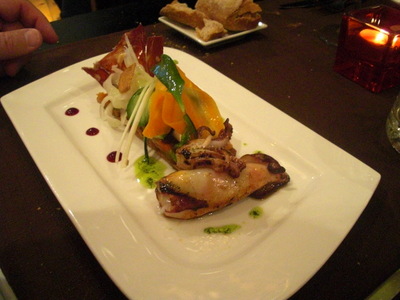
 First course, David: A little Parmesan, fromage blanc, and roasted red bell pepper tart garnished with all sorts of vegetables and, on the side, a grilled stuffed squid. In the background, you can see the small crispy bread rolls we were served.
First course, David: A little Parmesan, fromage blanc, and roasted red bell pepper tart garnished with all sorts of vegetables and, on the side, a grilled stuffed squid. In the background, you can see the small crispy bread rolls we were served.
First course, Jeff: Marinated organic salmon with beet reduction and a feta-and-avocado "almondine" (not sure just what that was, perhaps a pastry bundle with feta, avocado, and almonds?). I think the cylinder on the right is potato.

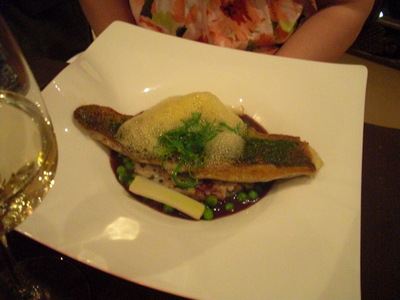 Main course, CJ: Grilled bar (Dicentrarchus labrax, Serranidae) with pesto, peas, green-bean risotto, and a sauce of butter beaten with red Côte du Rhône wine. Uncharacteristically, the menu did not say what the foam was made of.
Main course, CJ: Grilled bar (Dicentrarchus labrax, Serranidae) with pesto, peas, green-bean risotto, and a sauce of butter beaten with red Côte du Rhône wine. Uncharacteristically, the menu did not say what the foam was made of.
Main course, the rest of us: Cassoulet—a baked dish of large white beans, sausage, duck, pork, and lots and lots of garlic. David and I got the "menu portion," i.e., the serving size designed to be part of a multicourse meal. Jeff went for the full-size portion, showed here, which he quite handily finished off and still had room for dessert.
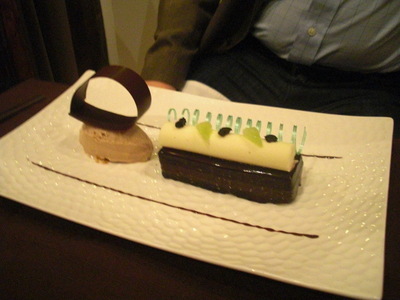
 Dessert, Jeff: Caribbean "chocolate finger" with milk-chocolate mousse and lemon milk sherbet. The spiral green spring was made of sugar.
Dessert, Jeff: Caribbean "chocolate finger" with milk-chocolate mousse and lemon milk sherbet. The spiral green spring was made of sugar.
Dessert, CJ: A little warm lemon-flavored cake with a molten center; quenelle of lemon sorbet.
Dessert, David and me (not pictured): Pistachio "sabayon" topped with a little cookie basket full of raspberries and strawberries. Sabayon is a sort of sweet hollandaise made with Marsala wine. It had been put in an earthenware dish and browned on top, so it looked just like a crème brullée but under the crust was much softer and fluffier. Yummy.
previous entry
List of Entries
next entry

 Vaison is also set up to handle large numbers of tourists, though on the cool and rainy day we were there, it wasn't at all crowded, and we parked easily. We found lunch at a café on the main square. We ate on the terrace, but the restaurants had set up large tents with clear plastic sides over the tables to ward off the wind and rain.
Vaison is also set up to handle large numbers of tourists, though on the cool and rainy day we were there, it wasn't at all crowded, and we parked easily. We found lunch at a café on the main square. We ate on the terrace, but the restaurants had set up large tents with clear plastic sides over the tables to ward off the wind and rain.
 I had another salad of foie gras, magret de canard, and toast. Once again, sigh, the toast was, well, not quite Wonderbread, but, say, Pepperidge Farm.
I had another salad of foie gras, magret de canard, and toast. Once again, sigh, the toast was, well, not quite Wonderbread, but, say, Pepperidge Farm.
 Because it was so cool and the rain was threatening, we started with the museum, where we would be indoors. On one wall, I found this great map of the Narbonne, the Roman province in which Provence was located. It stretches from what is now Nice at the right to beyond Toulouse at the left and from Marseille at the mouth of the Rhône (which is shown as a heavy blue line on the map) to Vienne (on the river just below the northern edge of the map) and Geneva at the top right.
Because it was so cool and the rain was threatening, we started with the museum, where we would be indoors. On one wall, I found this great map of the Narbonne, the Roman province in which Provence was located. It stretches from what is now Nice at the right to beyond Toulouse at the left and from Marseille at the mouth of the Rhône (which is shown as a heavy blue line on the map) to Vienne (on the river just below the northern edge of the map) and Geneva at the top right.
 Here CJ strolls among some of the denizens of the ruined houses and public buildings. She's small, but not that small—the statues are larger than life size. The one in the middle is the emperor Hadrian, and the room also included emperors Domitian and Claude. Several of the others were also of identified real people.
Here CJ strolls among some of the denizens of the ruined houses and public buildings. She's small, but not that small—the statues are larger than life size. The one in the middle is the emperor Hadrian, and the room also included emperors Domitian and Claude. Several of the others were also of identified real people.
 The model on the left here is of one of the houses that has been excavated. Only the foundations remain, revealing the layout, and the rest was reconstructed from what was already known about Roman architecture of the time.
The model on the left here is of one of the houses that has been excavated. Only the foundations remain, revealing the layout, and the rest was reconstructed from what was already known about Roman architecture of the time.
 The Roman theater is set into a hillside, but on the other side of the hill from the museum enclosure, facing away from the town. To get there the Romans (and, today, visitors) would have to walk up and over the top of the hill, but being the Romans, they couldn't be bothered to do that. Instead, partway up the hill, they drilled this pedestrian tunnel through the (mostly solid rock) hilltop. It comes out just a little above the side entrance to the theater, from which I took the photo on the right.
The Roman theater is set into a hillside, but on the other side of the hill from the museum enclosure, facing away from the town. To get there the Romans (and, today, visitors) would have to walk up and over the top of the hill, but being the Romans, they couldn't be bothered to do that. Instead, partway up the hill, they drilled this pedestrian tunnel through the (mostly solid rock) hilltop. It comes out just a little above the side entrance to the theater, from which I took the photo on the right.
 Back in Avignon, we strolled up to Les 5 Sens for dinner. We had the "Menu Gourmande," but it offered so many choices that we wound up eating many different things.
Back in Avignon, we strolled up to Les 5 Sens for dinner. We had the "Menu Gourmande," but it offered so many choices that we wound up eating many different things.
 First course, me: Foie gras two ways—a slice from a cold terrine and a tiny "slider" of saut&*eacute;ed foie gras in a miniature bun. On the side, round toasts, a quenelle of "vieux garçon" preserves, and a glass of sweet wine from Rasteau (one of the villages we had just driven through on the way to Vaison). To make vieux garçon ("bachelor") preserves, you put sugar and white fruit brandy in a large jar, then all season long, as fruit comes into season, you chop it up and stir it into the mix so that, by the end of the year, you've got a rich mixed-fruit preserve.
First course, me: Foie gras two ways—a slice from a cold terrine and a tiny "slider" of saut&*eacute;ed foie gras in a miniature bun. On the side, round toasts, a quenelle of "vieux garçon" preserves, and a glass of sweet wine from Rasteau (one of the villages we had just driven through on the way to Vaison). To make vieux garçon ("bachelor") preserves, you put sugar and white fruit brandy in a large jar, then all season long, as fruit comes into season, you chop it up and stir it into the mix so that, by the end of the year, you've got a rich mixed-fruit preserve.
 First course, David: A little Parmesan, fromage blanc, and roasted red bell pepper tart garnished with all sorts of vegetables and, on the side, a grilled stuffed squid. In the background, you can see the small crispy bread rolls we were served.
First course, David: A little Parmesan, fromage blanc, and roasted red bell pepper tart garnished with all sorts of vegetables and, on the side, a grilled stuffed squid. In the background, you can see the small crispy bread rolls we were served.
 Main course, CJ: Grilled bar (Dicentrarchus labrax, Serranidae) with pesto, peas, green-bean risotto, and a sauce of butter beaten with red Côte du Rhône wine. Uncharacteristically, the menu did not say what the foam was made of.
Main course, CJ: Grilled bar (Dicentrarchus labrax, Serranidae) with pesto, peas, green-bean risotto, and a sauce of butter beaten with red Côte du Rhône wine. Uncharacteristically, the menu did not say what the foam was made of.
 Dessert, Jeff: Caribbean "chocolate finger" with milk-chocolate mousse and lemon milk sherbet. The spiral green spring was made of sugar.
Dessert, Jeff: Caribbean "chocolate finger" with milk-chocolate mousse and lemon milk sherbet. The spiral green spring was made of sugar.